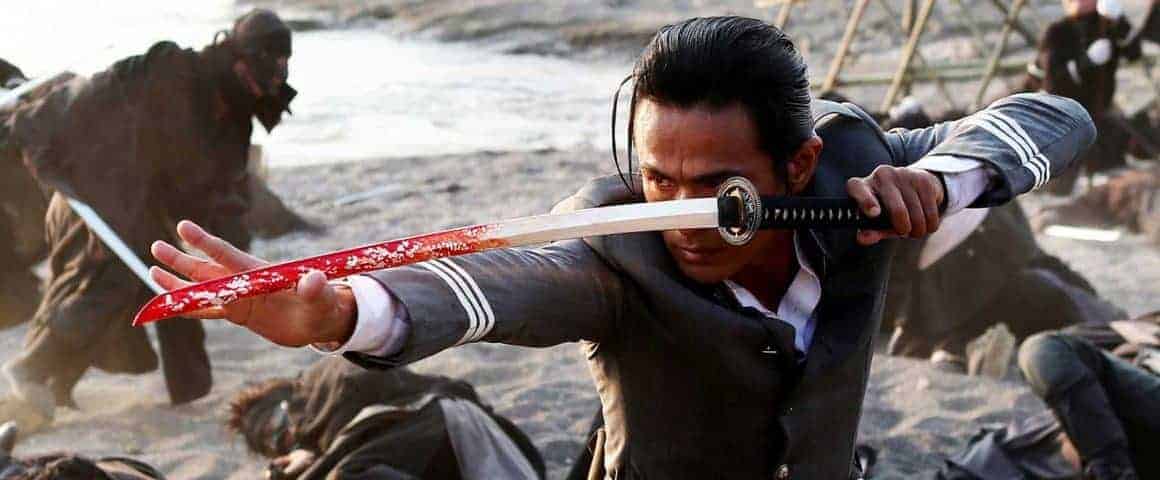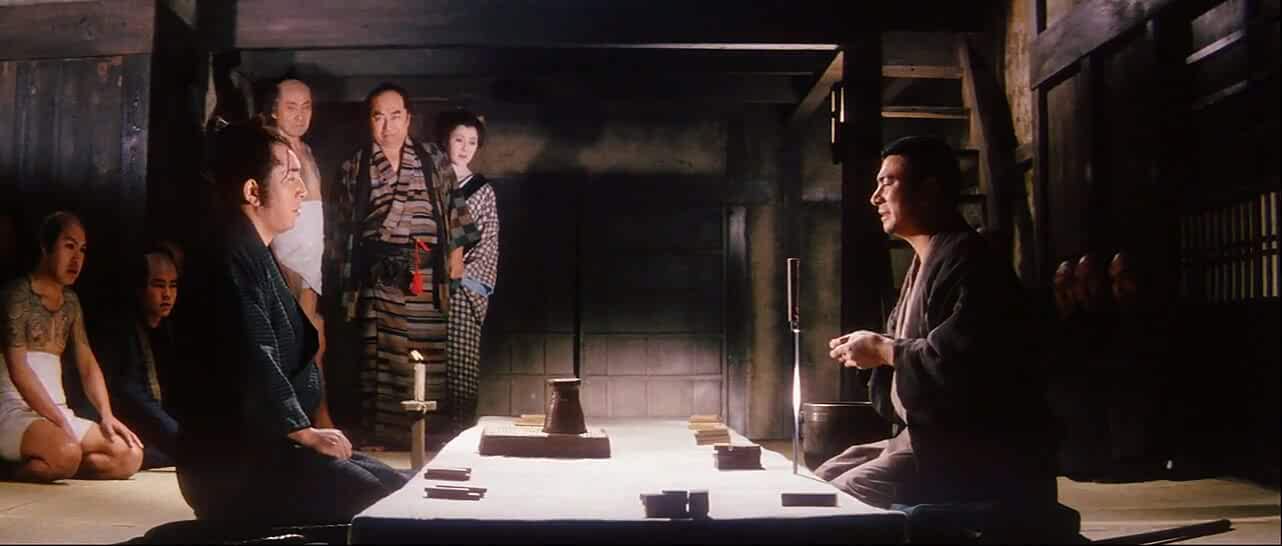Based on the homonymous and extremely popular samurai-themed manga (by Nobuhiro Watsuki) and anime, this live-action trilogy is the one that actually instigated the phenomenon of elaborate adaptations, particularly because it was one of the first (and one of the most successful) to make evident that in order for these kind of movies to actually work, a large budget is a necessity.
Buy This Title
In case you do not know the story (shame on you btw), the trilogy revolves around the adventures of Himura Kenshin, a ronin who has abolished his past as an assassin (under the name of Hitokiri Battosai) of the shogunate, after the Imperialist forces won the battle of Toba-Fushimi. As the first film begins, ten years have passed and Kenshin now wanders around carrying a katana with a reverse blade, essentially deeming it useless as a murder weapon, since he has vowed not to kill again. His path leads him to a poor dojo, run by Kamiya Kaoru and the two soon become friends, along with a homeless boy, Yahiko, who eventually takes shelter there. At the same time, Saito Hajime, a policeman who knew Kenshin from his past, is currently investigating the assassination of an undercover policeman. His research soon leads him towards Takeda Kanryu, a wealthy businessman, who is revealed to be responsible for the drugs sold in the area, which are manufactured by Megumi Takani, a woman forced to do so. Eventually she manages to escape and along with a street fighter named Sanosuke Sagara, joins Kenshin's “gang”. Three hardcore murderers, however, Udo Kine, Banjin Inui and Gein are helping Kanryu and the clash between the two factions is inevitable.
The second and third movie focus on the Kyoto arc, when another enemy, more terrible than anyone Kenshin has ever faced before, has risen, along with his band of killers and another businessman, Hoji Sadojima, and is threatening to plunge Tokyo into chaos, in order to exact revenge for the treatment of the former samurais by the current government. In order to face them, Kenshin has to find his teacher again and forge a new sword, after a battle with one of Shishio's subordinates, Soujiro Seta, proves that the obstacles he faces this time are much more than he can handle. Furthermore, a band of ninjas eventually comes to help him, although their former leader, Aoshi Shinomori, is actually seeking to kill Kenshin, for his own reasons.
Let me start with the most obvious. The casting of the trilogy is exceptional. Takeru Satoh (who has a black belt in Shorinji Kempo) is a great embodiment of Kenshin, since the combination of his physique, his abilities in Kempo and his acting resulted in a great lead that even received praise from Watsuki for his rendition of his hero. Emi Takei as the loveable Kaoru and Yu Aoi as the “benevolent witch” also follow in the same path, along with Yosuke Eguchi who makes for a great Saito. The fact that Ohtomo has stripped the movie from the slapstick/comedic moments of the anime worked quite well for the narrative, as it allowed the actors to focus on the dramatic and the action aspects of their part. The sole exception to this rule is Teruyki Kagawa who plays Kanryu hyperbolically, as a paranoid clown and Kenichi Takito, who follows in the same footsteps, although in a somewhat toned down fashion. Munetaka Aoki as Sanosuke is somewhere between, while the true accomplishment is that even Tatsuya Fujiwara's performance as Shishio is not as excessive as usual.
In the first movie, it seemed to me that not much attention was given to the villains, maybe with the exception of Koji Kikkawa who is great as Udo Jine, but even this aspect was “corrected” in the two later parts, with the focus being in the accuracy of the depiction of the characters. In that fashion, and although there was not enough time to analyze all the villains thoroughly, Ohtomo still managed to present number of captivating portraits, with Yusuke Iseya as Aoshi, Ryonosuke Kamiki as Soujiro, along Masaharu Fukuyama as Kenshin's teacher, Seijuro, benefitting the most from the time allocated to their roles. The overall result is a number of characters that look really cool and not ridiculous in any way, something that works wonders for the films and the overall accuracy in the portrayal of the original. The trademark moves of Kenshin, Aoshi and Soujiro are among the highlights of this approach.

Of course, with this kind of title, the action is probably the most important aspect and the result in that department, is even more impressive. The abilities of the aforementioned actors (and the stuntmen of course) benefit and are benefited the most by the exceptional action and stunts choreographies by Kenji Tanigaki and Takahito Ouchi, who focused on the speed of the scenes with great results. Tsuyoshi Imai's editing also implements this speed with many and well placed cuts, while the slower pace he implements in the non-action scenes also works quite well for the overall narrative. DOP Takuro Ishizaka's camera follows the action artfully, while he does not fail to highlight the beauties and the ugliness of the various settings the story takes place. Lastly, Naoki Sato's atmospheric to the point of ritualistic (somewhat reminded me of Dead Can Dance sounds) music “coats” the scenes excellently, adding to the epicness of the trilogy and its overall aesthetics. The only fault I found in that regard is that the use of the same musical motif becomes a bit tiring after a time, particularly if one watches the last two films consecutively, while a number of scenes look a bit too melodramatic through the use of music.
Furthermore, and in another element that makes the franchise, as a whole, to stand out from the many in the shonen/action category, is the context. The end of the era of samurais is one of the most interesting in Japanese history, particularly through the violent ways it occurred, through Commodore Perry's infamous Black Ships. The bitterness of the people that supported the shogunate, who found themselves stripped of any value completely abruptly as the new modern era hit Japan in a rush, has always been a very interesting topic for cinema and the industry in general, and Ohtomo (and Watsuki in essence) take full advantage of it to present their characters and the various events that take place. Kenshin's decision to completely change his ways is what brings him against a number of enemies that could have been comrades in the previous era, and whose feelings of betrayal by the government have led them to become bitter and vengeful. Aoshi, but most of all Shishio, are the main embodiments of this aspect, while the way the latter has planned his revenge is a direct accusation to the way Perry implemented the will of the Westerners to Japan.

The hungry, ragtag samurais that appear all over the trilogy, trying to survive in a world that has no need for them anymore are another evidence of the circumstances of the era. Kenshin himself seems to be the embodiment of the search for a new role for the samurais, although the story of the franchise actually forces him to stop searching and return to his old ways in order to save the government, and in essence, the new way of life. In that fashion, the story also makes a point of highlighting the fact that the samurais were necessary for the unable to act government, but only against other samurais, thus ending the circle of their traditional presence in Japanese society. On a last comment, love, and peace and quiet seem to be the way for them to go, although in the trilogy this part is only highlighted in the last scene.
Not much more to say, “Rurouni Kenshin” (Samurai X if you prefer), is one of the greatest manga/anime franchises of all time and the trilogy makes justice to the original. In a last note, I cannot wait to see the adaptation of the two OVA's (one that tells the beginning of the story of Kenshin and one the end) of the series, that will screen this summer in Japan.
















